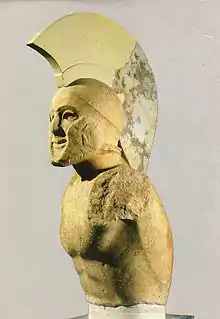Leonidas (sculpture)
Leonidas is a sculpture of a hoplite made of Parian marble in 480–470 BC and unearthed in 1926. The sculpture was dubbed "Leonidas" by a local Greek workman after its discovery, in reference to Spartan king Leonidas I.[1] It was found southwest of peribolos of the Athena Chalkioikos on the Acropolis of Sparta.[2] The sculpture is housed in the Archaeological Museum of Sparta, which acquired it from the British School at Athens in 1926.[3] The sculpture features a Corinthian helmet with ram-shaped cheek pieces. While most of the plume is a restoration, fragments of a leg, foot, shield and helmet were also found nearby.[3]
| Leonidas | |
|---|---|
 | |
| Artist | Unknown |
| Year | 480–470 BC |
| Medium | Parian marble |
| Dimensions | 78 cm (31 in) |
| Location | Archaeological Museum of Sparta |
The sculpture was part of a group, probably affixed to the sanctuary pediment. According to several scholars, it formed part of the memorial on the Spartan acropolis to honor Leonidas on his reburial.[4] Paul Cartledge, however, argued it would have represented a mythical hero or a god rather than the historical person of Leonidas.[1] One estimation dates the sculpture before rather than after 480 BC, the year of the Battle of Thermopylae where Leonidas died.[1]
References
- Paul Cartledge (2006). Thermopylae: The Battle That Changed the World. The Overlook Press. ISBN 1590208404.
- "New York, USA. "Athens-Sparta: from the 8th to the 5th Centuries B.C." – Exhibition" (PDF). Onassis.org. Retrieved 17 March 2017.
- ""Leonidas"". University of Cambridge Museum of Classical Archaeology Databases. Retrieved 17 March 2017.
- Nic Fields (2007). Thermopylae 480 BC. Osprey Publishing. p. 32. ISBN 978-184176-180-0.